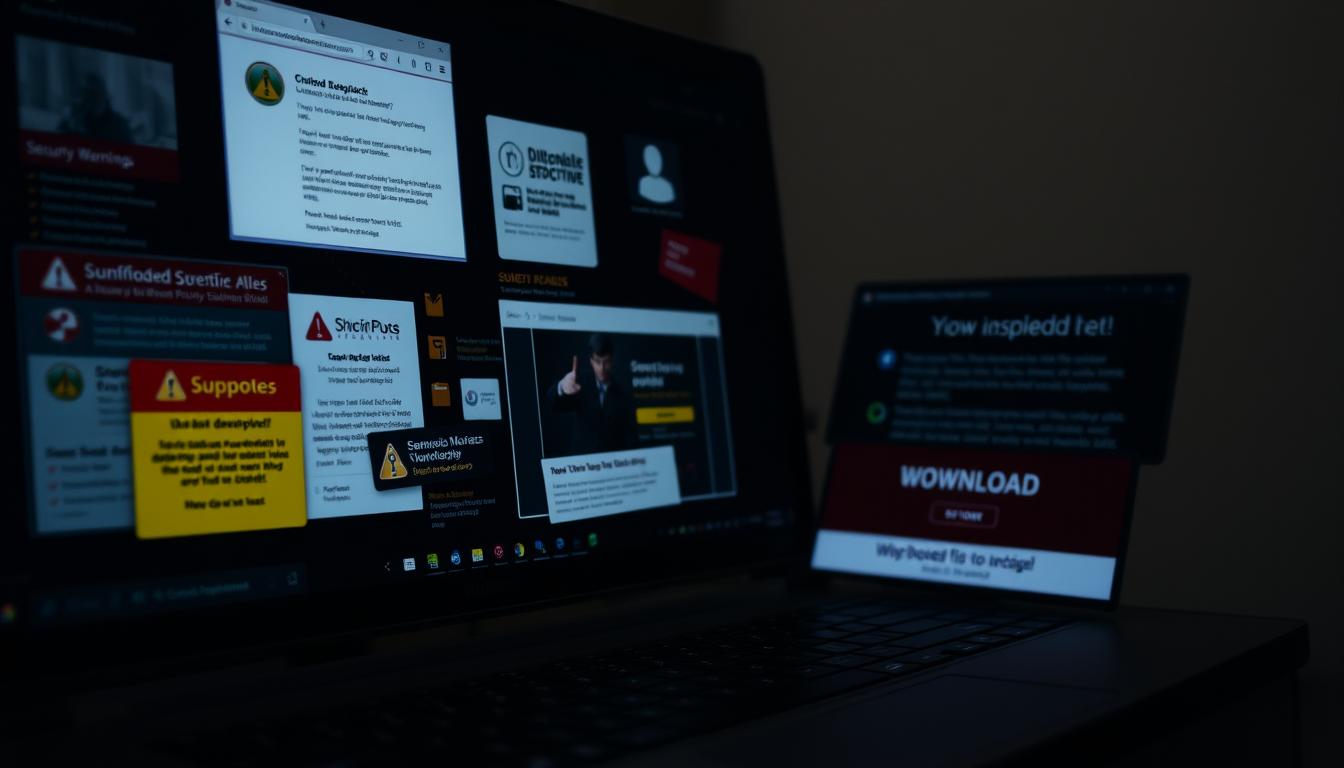Is your device acting strange lately? It may be more than fair a glitch. Cybersecurity threats are on the rise, and knowing if your device is hacked is key. Hackers often leave behind warning signs—a digital security alert can help you spot a compromised device before it’s too late.
Recognizing the signs of hacking is crucial for protecting your personal and sensitive information. With vulnerabilities in both mobile and desktop platforms, staying alert is essential. Statistics show a huge increase in digital breaches, making it vital to be proactive in securing your digital life.

Key Takeaways
-
Look for unusual behavior in your device.
-
Be aware of changes in battery performance.
-
Watch for unexpected pop-ups and slow performance.
-
Monitor accounts for strange activity.
-
Regularly inspect installed applications.
Unusual Battery Drain
Unusual battery drain can be a sign that your device has been hacked. Knowing how your device usually uses battery power helps spot problems. This way, you can find out if your device has been compromised.
Understanding Battery Usage
Devices usually use battery power in a predictable way. This depends on things like app use or screen brightness. If your battery channels quicker than regular, it may be a caution sign.
Keeping an eye on your battery health is key to staying safe. It helps you notice any unusual activity early on.
Potential Causes of Rapid Drain
There are several reasons why your battery might drain quickly. Some possible causes include:
-
Background malware processes that consume resources while compromising your device.
-
Software updates running without your consent, leading to increased power consumption.
-
Malicious applications intentionally draining battery to monitor your communications or track your location.
These issues can influence your device’s execution and appear signs of an information breach. It’s important to act fast if you notice your battery draining unusually.

Unexpected Pop-Ups on Your Device
Seeing startling pop-ups on your gadget can be scary. They often mean someone is trying to hack you or your device has malware. It’s important to know how to spot these ads to keep your online world safe. These pop-ups might look like real messages, saying your antivirus needs an update or there’s a big problem.
Identifying Malicious Pop-Ups
When you see pop-ups on your phone, watch for certain signs they might be bad. Look for:
-
Urgent requests for personal information
-
Unexpected offers or rewards
-
Pop-ups that lead you to unfamiliar websites
These signs are like red flags. They often mean your device might have malware. It’s key to tell the difference between safe and unsafe pop-ups.
How to Block Annoying Pop-Ups
Stopping pop-ups can make your web surfing better. Here’s how:
-
Change your browser settings to block pop-ups.
-
Use good ad-blocker extensions for extra safety.
-
Keep your browser and program updated to stay secure.
By doing these things, you can cut down on pop-ups and lower hacking risks. Being careful is crucial to secure your data and devices.

Slow Device Performance
Slow device performance can really mess up your day. It makes your device slow to react, causing frustration and lowering your productivity. It’s not just annoying; it can also make you unhappy with your device.
Knowing why your device is slow is key. It helps you figure out how to fix it. This includes checking if your device might have been hacked.
How Performance Impacts User Experience
Slow devices cause annoying delays and freezes. Apps take longer to open, and your device might freeze. These problems make it hard to work or have fun.
Slow performance really hurts your experience. Many people think their device might be hacked because of it.
Common Reasons Behind Slow Performance
There are many reasons for slow devices. Malware that stows away and employs up assets could be an enormous concern. Spyware or apps running in the background without permission also slow things down.
Reports show more slow devices are linked to digital threats. Knowing almost these issues makes a difference keep your gadget quick and safe.

How to Know if Your Device is Hacked
It’s important to know if your device is hacked to keep your digital life safe. There are many signs that show if someone has accessed your data without permission. Spotting these signs early helps you fight off cyber threats and act fast.
Signs of Unauthorized Access
Watch for warning signs that might mean someone has accessed your device without your okay. Some common signs are:
-
Sudden changes to account settings that you did not initiate.
-
Unfamiliar activity in your email or social media accounts.
-
Unrecognized login attempts or notifications regarding logins from unfamiliar locations.
Seeing any of these signs means you need to check if your device is at risk. It’s a big deal for your security.
Indicators of Malware Infection
Spotting malware infection signs is key to acting quickly. Look out for:
-
Increased data usage that doesn’t align with your regular activities.
-
Frequent crashes or spontaneous rebooting of your device.
-
Unexpected error messages that can disrupt your tasks.
These signs mean your device might be in trouble. They tell you it’s time to find out if your device is hacked and how urgent it is.

Strange Activity on Your Accounts
In today’s digital world, it’s key to watch for odd behaviors in your accounts. Seeing strange activity on your device might mean someone is trying to hack you. Look out for unauthorized messages, as they can be a big risk for you and your friends.
Recognizing Unauthorized Messages
Unusual messages often pop up out of nowhere from your accounts. You might see texts or emails that you didn’t send. These messages might ask for personal info or have links to bad sites.
It’s important to spot these messages. They can trick your friends into sharing personal details or visiting dangerous websites.
Monitoring Account Activity
Keeping an eye on your account movement is crucial. Look over your statements often for anything you don’t know about. Advanced security cautions can moreover caution you of odd happenings right away.
Here are some good steps to take:
-
Set up alerts for when someone tries to log in from a new place.
-
Check recent activities to find any unauthorized access.
-
Change your passwords often and use two-factor authentication if you can.
Quick action when you see something odd can protect your accounts. Always be on the lookout for strange activity on your device.
Unknown Apps Installed on Your Device
You might not know, but unknown apps on your device can be a big risk. It’s important to check your phone or tablet apps regularly. This helps keep your personal info safe. By looking at your apps, you can spot any unwanted ones and lower the chance of a security problem.
Inspecting Installed Applications
Begin by looking at each app on your device. Here’s how to check your apps:
-
Go to the settings menu on your device.
-
Select “Apps” or “Applications” to see a list of all installed apps.
-
Look at the names and icons for anything you don’t know.
-
If you find an app you don’t know, search it online to learn more.
Being careful about unknown apps is crucial to stop unauthorized access to your device.
How to Remove Suspicious Apps
If you find a suspicious app installed, you need to act fast. Here’s how to safely remove it from your phone:
-
Navigate to the settings menu again and tap on “Apps.”
-
Find the suspicious app on the list.
-
Select the app and click “Uninstall” or “Remove.”
-
Also, think about getting a good antivirus app. It can help find and deal with threats.
Be active in managing your device by deleting any apps you don’t know. This simple step can greatly improve your security and prevent more problems.
Conclusion
In this article, you learned how to spot if your device has been hacked. Signs include unusual battery drain and unknown apps. It’s key to know these signs to keep your digital world safe.
To protect your device, run antivirus scans often, change passwords, and update software. These steps boost your defense against hackers. In addition, watch for odd account activities to capture perils early.
Being proactive in digital safety is vital. Stay alert and monitor your devices closely. This way, you can keep your online space safe and secure. Stay informed and protect your digital world.



GIPHY App Key not set. Please check settings